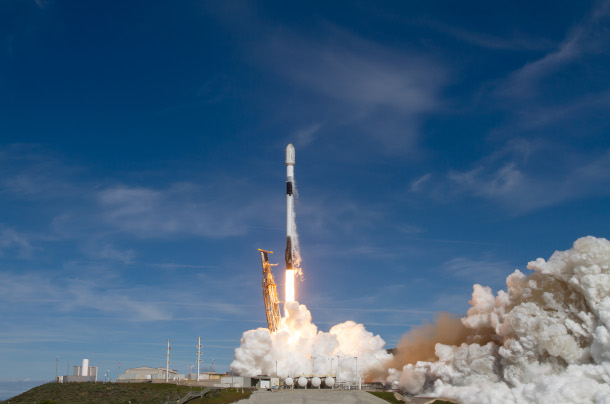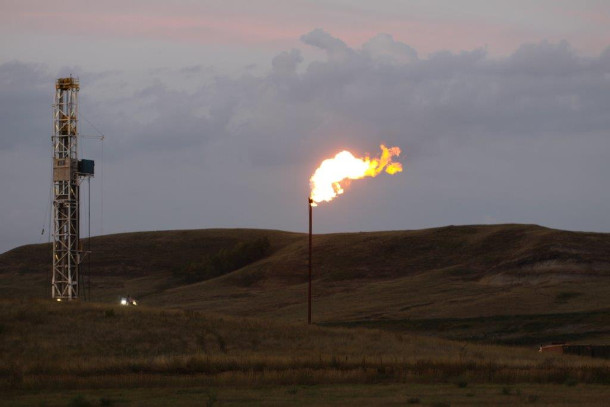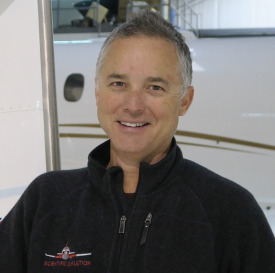Methane Tracking From Space
Air Date: Week of March 15, 2024

MethaneSAT launched on March 4th, 2024. (Photo: Courtesy of SpaceX, via Environmental Defense Fund)
A new satellite recently blasted off into Earth orbit with the important mission of tracking methane emissions from oil and gas infrastructure across the globe. Dr. Stephen Conley is an atmospheric scientist and joins Host Aynsley O’Neill to explain why free public access to the data from MethaneSAT is a game-changer for holding oil and gas companies accountable for climate pollution.
Transcript
DOERING: From PRX and the Jennifer and Ted Stanley Studios at the University of Massachusetts, Boston this is Living on Earth. I'm Jenni Doering.
O’NEILL: And I’m Aynsley O’Neill.
Today on the show, we’re launching into space.
[COUNTDOWN:… 3, 2, 1… Ignition and Liftoff… ]
O’NEILL: On March 4th, a new satellite with special methane detectors blasted off into Earth orbit. MethaneSAT, led by Environmental Defense Fund and launched by SpaceX, has the important mission of tracking methane emissions from oil and gas infrastructure across the globe. Methane is a powerful greenhouse gas that can be 80 times more potent than carbon dioxide, so it’s a major contributor to climate disruption. While some private entities are already using satellites to track methane emissions, MethaneSAT is the first initiative to make the information free and accessible to the general public. Dr. Stephen Conley is an atmospheric scientist and the founder of Scientific Aviation, which conducts plane-based measurements of methane and other greenhouse gases. He has worked with Environmental Defense Fund in the past, though he is not involved in MethaneSAT. He joins me now for more. Dr. Conley, welcome to Living on Earth!
CONLEY: Thank you. I'm happy to be here.

An infrastructure tank’s methane flare in Bakken Shale Fields, Mississippi. Methane is a greenhouse gas that is 80 times more potent than carbon dioxide when first released. (Photo: Trudy E. Bell, Flickr, CC BY-NC-ND 2.0)
O'NEILL: So please start us off with an overview about the project. What are we going to learn from this?
CONLEY: I think what's different about MethaneSAT is this is going to bring much needed transparency to the industries. So it's interesting because if you go back to, say, 12 years ago, nobody was talking about methane, like it just wasn't on the radar. And it was EDF, the Environmental Defense Fund, that really brought methane to the forefront. So they started doing these studies with lots of aircraft flying around. In fact, we did a bunch of their flights, like all over the country. And what they started to do was bring awareness to the methane problem and started this discussion. And one of the challenges that we face is that you need to be able to separate the people in the industry that are doing the right thing from those who aren't, because not all oil companies are created equal--the same for every industry, right? Some landfills are doing a fabulous job of capturing their methane emissions, and some aren't. And so how do you separate them? And what's different about MethaneSAT, and I think what's going to make a profound impact on our emissions, is that all of a sudden, it's that old--was that Ronald Reagan?--"you can run but you can't hide," that now you're gonna have this satellite flying over. And it's actually giving everyone free access to data on who's emitting what, where. And like, right now, we have plenty of satellites that are flying around looking at methane emissions. But they're very expensive to use their data. They're not free. And EDF is making this data publicly available. So everybody's gonna have it. Now, the United Nations has a program where they're monitoring, the International Methane Emissions Observatory. And so I have been talking with them for years, and it's almost gleeful. They're so excited, because at the moment, they're getting most of their data from voluntary reporting. And this is going to sort of be this spy in the sky. It's like, all of a sudden, someone that's watching and giving them the ability to confirm those reports. So that I think is what's going to cause the effectiveness, it's not so much that it's a new technology as it is, it's publicly available.
O'NEILL: And what kind of reactions to this project have you seen from the fossil fuel industry, if any?
CONLEY: So you know, it's interesting, because if you think about it, the companies that are trying to do the right thing, in a way they get put at a competitive disadvantage, when there's sort of no accountability for those that don't, right, because it's obviously less expensive to not do the right thing. And so, both with regulation and with stuff like this, those companies that are taking the right steps are going to be happy about the fact that now there's going to be some public accountability for the fact that we are doing the right thing and others are not, it's gonna help to level the playing field. So I have actually heard good reactions from those companies.
O'NEILL: And what about a major fossil fuel emitter like Exxon or Chevron?
CONLEY: Well, here's a good way to look at this. So there's this organization called the Oil and Gas Methane Protocol [editor’s note: the full title is Oil and Gas Methane Partnership] connected to the United Nations organizations. It's totally voluntary. But as far as I know, all of the super majors, at least the ones that we deal with here in the United States, have joined. So Chevron, Exxon, Shell, ConocoPhillips, they're all part of that, which in itself requires sort of a higher level of attention to the emissions. So I would say, statistically, those super large companies are less of a worry to me than the small ones. Well, one of the typical problems that gets us is that a super large company builds a well, and in the beginning, it's producing tons, it's very valuable. And as that production drops off over the years, ultimately it becomes not profitable to apply their standards to it. And so it ends up getting sold to a smaller operator. And those smaller operators often don't have that level of attention.
O'NEILL: Now, Dr. Conley, you've been working in this field generally for about two decades or so. Why is it that this is happening now, in 2024? What is sort of been a hurdle to it happening earlier?
CONLEY: Oh, a few things. So obviously, one of them is money. There's other operators that have satellites that look at methane, but they had a commercial model. So getting funding was, I don't want to say easy, but it was easier because there was a potential to make a lot of money off of that. Now, EDF had to raise money from people who are just interested in stopping the methane emissions. The other thing I think that's happening simultaneously is the urgency is increasing. So when you see these reports from the Panel on Climate Change, IPCC, where they talk about the timing now that--I think the last one was that we have 12 years to get our emissions under control before we reach the tipping point and it's too late. I think those kinds of statements coming out that stress the urgency are what's sort of driving all this stuff forward in 2024. It's that convergence of funding available and urgent need for change.

Dr. Stephen Conley is an atmospheric scientist, pilot, and programmer. He created Scientific Aviation in 2010 and spent the next decade developing systems for methane emissions detection and quantification. Scientific Aviation was acquired by ChampionX in 2021. (Photo: Courtesy of Stephen Conley.)
O'NEILL: Dr. Conley, what is the big takeaway from this new project?
CONLEY: What this means, bottom line, beyond all the other talk, is transparency. You've got this device that's circling the planet. And all it's doing is telling us when somebody has a problem. When we started doing these flights a decade ago, or actually 14 years ago, it was interesting, because at that time, nobody had flown over oil and gas sites. And so in the beginning, we got a lot of pushback from the property owners, from the operators, saying that you're not allowed to fly over us. And the answer is we are allowed, it's part of the FAA rules. But that brought a level of transparency, because all of a sudden, one of these operators knew that this plane could show up at any time. But they knew the plane was there. That's the difference. With the satellite, you don't know it's there. You're not looking up at the sky and you see the satellite like you do with an airplane. So you've got an operation that's just going on. And the satellite goes over and takes this picture when you weren't even aware of it. Historically, we've had these environmental advocates that would go and they would cut the lock on the site, and they'd go on with their optical gas imaging camera. And then they would send a picture to the New York Times, right, they'd break the law. And so EPA was very clear that you cannot go on to someone's site without permission to get this data that we're going to use in enforcement. While that's not an option, now, if I'm an environmental advocate, all I have to do is start downloading this data from EDF and go match it up to sites, like I can now be just an ordinary citizen, and I can get this data and then go start reporting to the EPA. And so that's where I think that this is going to be so profound in its importance, because every time you have one of these emissions, you're going to be wondering, like, was someone looking?
O'NEILL: Dr. Stephen Conley is an atmospheric scientist and founder of Scientific Aviation. Thank you so much for joining us today.
CONLEY: It was great to be here. Thanks for having me.
Links
The New York Times | “Tracking an Invisible Climate Menace From 360 Miles Above”
Living on Earth wants to hear from you!
Living on Earth
62 Calef Highway, Suite 212
Lee, NH 03861
Telephone: 617-287-4121
E-mail: comments@loe.org
Newsletter [Click here]
Donate to Living on Earth!
Living on Earth is an independent media program and relies entirely on contributions from listeners and institutions supporting public service. Please donate now to preserve an independent environmental voice.
NewsletterLiving on Earth offers a weekly delivery of the show's rundown to your mailbox. Sign up for our newsletter today!
 Sailors For The Sea: Be the change you want to sea.
Sailors For The Sea: Be the change you want to sea.
 Creating positive outcomes for future generations.
Creating positive outcomes for future generations.
 Innovating to make the world a better, more sustainable place to live. Listen to the race to 9 billion
Innovating to make the world a better, more sustainable place to live. Listen to the race to 9 billion
 The Grantham Foundation for the Protection of the Environment: Committed to protecting and improving the health of the global environment.
The Grantham Foundation for the Protection of the Environment: Committed to protecting and improving the health of the global environment.
 Contribute to Living on Earth and receive, as our gift to you, an archival print of one of Mark Seth Lender's extraordinary wildlife photographs. Follow the link to see Mark's current collection of photographs.
Contribute to Living on Earth and receive, as our gift to you, an archival print of one of Mark Seth Lender's extraordinary wildlife photographs. Follow the link to see Mark's current collection of photographs.
 Buy a signed copy of Mark Seth Lender's book Smeagull the Seagull & support Living on Earth
Buy a signed copy of Mark Seth Lender's book Smeagull the Seagull & support Living on Earth

